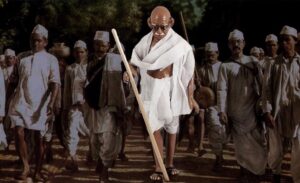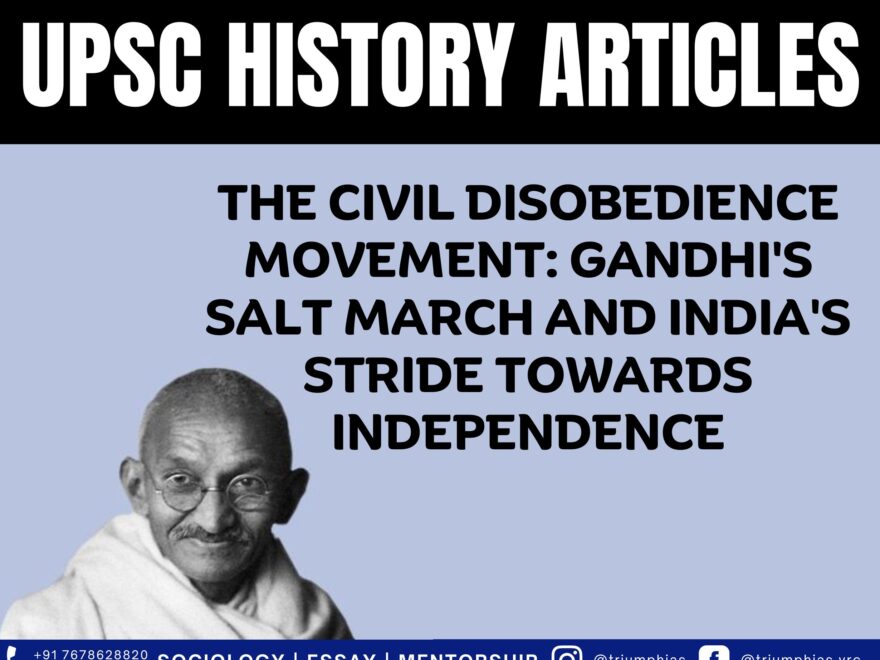The Civil Disobedience Movement
(Relevant for Historical Section of General Studies Paper Prelims/Mains)

Civil Disobedience Movement
The inception of the civil disobedience movement can be attributed to the Dandi March, also renowned as the Salt March. The Dandi Satyagraha marked a nonviolent act of civil disobedience spearheaded by Mohandas Karamchand Gandhi. This campaign embraced direct action by means of tax resistance and nonviolent protest against the British-imposed salt monopoly. In this endeavor, Gandhi and his supporters openly challenged British policies by manufacturing salt from seawater.
As the movement gained momentum, numerous individuals joined Gandhi’s cause, and in coastal cities such as Bombay and Karachi, Indian nationalists rallied crowds to participate in salt-making activities. This symbolic act of defying the salt laws played a pivotal role in catalyzing the emergence of the civil disobedience movement.
Causes of Civil Disobedience Movement (CDM)
- The genesis of the Civil Disobedience Movement (CDM) can be traced back to the Dandi Salt March, initiated due to the government’s monopoly over salt production and trade, coupled with the imposition of a salt tax on every citizen.
- The stringent regulations were to such an extent that even a mere gathering of sea salt from the sands could result in fines being levied against individuals.
- Furthermore, a surge of nationalist sentiment began to resonate among the masses due to the events surrounding the Simon Commission of 1928. This commission, devoid of any Indian representation, failed to involve Indians in crucial constitutional decision-making processes. This lack of recognition of dominion status aspirations, along with the unjust apprehension of social reformists, further fuelled the growing patriotic sentiment.
- As tensions escalated in this backdrop, the Civil Disobedience Movement experienced a rapid and impactful ascent.
Significance of the Civil Disobedience Movement (CDM):
- Decline in British Imports: A notable reduction was observed in imports from Britain, with an illustrative instance being the halving of cloth imports from the British.
- Extensive Participation across India: Originating on the western coast of India, the movement’s influence swiftly spread across the entire nation. Demonstrations of significant scale occurred in key cities like Madras, Calcutta, Karachi, Bombay, Delhi, and Sholapur, primarily in response to the respective arrests of Nehru and Gandhi during April and May.
- Inclusivity of Various Segments: This movement demonstrated a broader reach compared to its predecessor. Its participants encompassed a wide spectrum, including women, peasants, workers, students, and urban entities like merchants and shopkeepers. This expanded participation bolstered the Congress’s newfound pan-Indian stature.
- Remarkable Backing from the Marginalized: The movement’s resonance among the indigent and uneducated, both in urban and rural locales, was truly exceptional.
- Global Acknowledgment: In the initial stages, the act of breaking the salt law’s significance went largely unnoticed. Even Viceroy Lord Irwin held the belief that it would have minimal impact on the general populace. However, during his journey to Dandi, Gandhi addressed vast gatherings, encouraging a considerable number of individuals to join the march. This iconic procession catapulted India’s fight for independence to the forefront of international news coverage. It’s noteworthy that the front page of the American weekly magazine Time featured a photograph of Gandhi along with a depiction of British oppression and the potency of nonviolent resistance.
- Female Engagement: An additional pivotal facet of this movement was the active involvement of women. This marked a significant moment as women contributed substantively to the picketing of opium dens, liquor stores, and establishments selling foreign clothing. Rani Gaidinliu, a spiritual leader from the Naga community, boldly raised the banner of rebellion against British colonization.
Evaluation
- Despite a notable 50% reduction in foreign imports of clothing and cigarettes, alongside decreased government revenue from land revenue and liquor excise, the growth of the Indian domestic industry remained limited. Furthermore, Indian exports didn’t witness significant escalation.
- The culmination of these events led to a ceasefire, ultimately formalized as the Gandhi-Irwin Pact. This agreement paved the path for Gandhi, acting on behalf of the Indian National Congress, to participate in the second session (September–December 1931) of the Round Table Conference held in London.
The earlier movements were restricted to urban areas; the civil disobedience movement was the first to operate on a national level. Rural residents were given the chance to engage in this movement. Further, it steered the Indian Independence Struggle toward complete independence, it was unquestionably a turning moment in the movement.
Sample Question for UPSC Sociology Optional Paper:
1. What was the Dandi March and how did it lead to the Civil Disobedience Movement?
The Dandi March was a nonviolent act of civil disobedience initiated by Gandhi to protest British-imposed salt laws. It catalyzed the larger Civil Disobedience Movement by challenging British authority and inspiring widespread public participation.
2. Who was involved in the Civil Disobedience Movement and what did its inclusivity signify?
The movement was inclusive, involving various social segments like women, peasants, workers, students, merchants, and shopkeepers. This wide reach symbolized a unified Indian resistance against British rule.
3. What were the economic consequences of the Civil Disobedience Movement for British colonial rule?
The movement led to a significant decline in British imports, notably halving cloth imports, and decreased government revenue from land and liquor excise, severely impacting the British economy.
4. How did the Simon Commission contribute to the rise of the Civil Disobedience Movement?
The Simon Commission, which lacked Indian representation, alienated the Indian populace and fueled nationalist sentiments, serving as a precursor to the Civil Disobedience Movement.
5. What role did women play in the Civil Disobedience Movement?
Women actively participated in picketing and protests, contributing to the boycott of foreign goods and establishments like opium dens and liquor stores, thus broadening the movement’s social base.
6. What was the global impact of the Civil Disobedience Movement?
The movement gained international attention, especially after the Dandi March. Time magazine featured Gandhi on its front page, highlighting the global significance of India’s struggle for independence.
7. What was the Gandhi-Irwin Pact and what did it signify?
The Gandhi-Irwin Pact was an agreement between Gandhi and the Viceroy Lord Irwin that ended the Civil Disobedience Movement and allowed Congress participation in the Round Table Conference, indicating a significant, albeit temporary, shift in British policy.
8. How did the Civil Disobedience Movement differ from earlier movements in its scope and reach?
Unlike earlier movements restricted to urban areas, the Civil Disobedience Movement had a national scope, enabling rural participation and making it a turning point in the Indian Independence Struggle.
9. Discuss the contribution of Rani Gaidinliu in the context of the Civil Disobedience Movement.
Rani Gaidinliu, a spiritual leader from the Naga community, significantly contributed by raising the banner of rebellion against British colonization, extending the movement’s influence to marginalized communities.
10. Why was the Civil Disobedience Movement considered a turning point in the Indian Independence Struggle?
The movement marked a shift towards complete independence as its ultimate goal, broadening its social base, affecting British economic interests, and setting the stage for future anti-colonial movements.
To master these intricacies and fare well in the Sociology Optional Syllabus, aspiring sociologists might benefit from guidance by the Best Sociology Optional Teacher and participation in the Best Sociology Optional Coaching. These avenues provide comprehensive assistance, ensuring a solid understanding of sociology’s diverse methodologies and techniques.
Civil Disobedience Movement, Dandi March, Salt March, Gandhi, Indian Independence, British rule, Simon Commission, Gandhi-Irwin Pact, Round Table Conference, Time magazine, nationalist sentiment, nonviolent resistance, women in freedom struggle, Indian National Congress, Civil Disobedience Movement, Dandi March, Salt March, Gandhi, Indian Independence

Choose The Best Sociology Optional Teacher for IAS Preparation?
At the beginning of the journey for Civil Services Examination preparation, many students face a pivotal decision – selecting their optional subject. Questions such as “which optional subject is the best?” and “which optional subject is the most scoring?” frequently come to mind. Choosing the right optional subject, like choosing the best sociology optional teacher, is a subjective yet vital step that requires a thoughtful decision based on facts. A misstep in this crucial decision can indeed prove disastrous.
Ever since the exam pattern was revamped in 2013, the UPSC has eliminated the need for a second optional subject. Now, candidates have to choose only one optional subject for the UPSC Mains, which has two papers of 250 marks each. One of the compelling choices for many has been the sociology optional. However, it’s strongly advised to decide on your optional subject for mains well ahead of time to get sufficient time to complete the syllabus. After all, most students score similarly in General Studies Papers; it’s the score in the optional subject & essay that contributes significantly to the final selection.
“A sound strategy does not rely solely on the popular
Opinion of toppers or famous YouTubers cum teachers.”
It requires understanding one’s ability, interest, and the relevance of the subject, not just for the exam but also for life in general. Hence, when selecting the best sociology teacher, one must consider the usefulness of sociology optional coaching in General Studies, Essay, and Personality Test.
The choice of the optional subject should be based on objective criteria, such as the nature, scope, and size of the syllabus, uniformity and stability in the question pattern, relevance of the syllabic content in daily life in society, and the availability of study material and guidance. For example, choosing the best sociology optional coaching can ensure access to top-quality study materials and experienced teachers. Always remember, the approach of the UPSC optional subject differs from your academic studies of subjects. Therefore, before settling for sociology optional, you need to analyze the syllabus, previous years’ pattern, subject requirements (be it ideal, visionary, numerical, conceptual theoretical), and your comfort level with the subject.
This decision marks a critical point in your UPSC – CSE journey, potentially determining your success in a career in IAS/Civil Services. Therefore, it’s crucial to choose wisely, whether it’s the optional subject or the best sociology optional teacher. Always base your decision on accurate facts, and never let your emotional biases guide your choices. After all, the search for the best sociology optional coaching is about finding the perfect fit for your unique academic needs and aspirations.
To master these intricacies and fare well in the Sociology Optional Syllabus, aspiring sociologists might benefit from guidance by the Best Sociology Optional Teacher and participation in the Best Sociology Optional Coaching. These avenues provide comprehensive assistance, ensuring a solid understanding of sociology’s diverse methodologies and techniques. Sociology, Social theory, Best Sociology Optional Teacher, Best Sociology Optional Coaching, Sociology Optional Syllabus.
Best Sociology Optional Teacher, Sociology Syllabus, Sociology Optional, Sociology Optional Coaching, Best Sociology Optional Coaching, Best Sociology Teacher, Sociology Course, Sociology Teacher, Sociology Foundation, Sociology Foundation Course, Sociology Optional UPSC, Sociology for IAS,
Follow us :


https://t.me/VikashRanjanSociology
Find More Blogs
|
Scope of the subject and comparison with other social sciences |
|||
|
|
|
|
Modernity and social changes in Europe |

